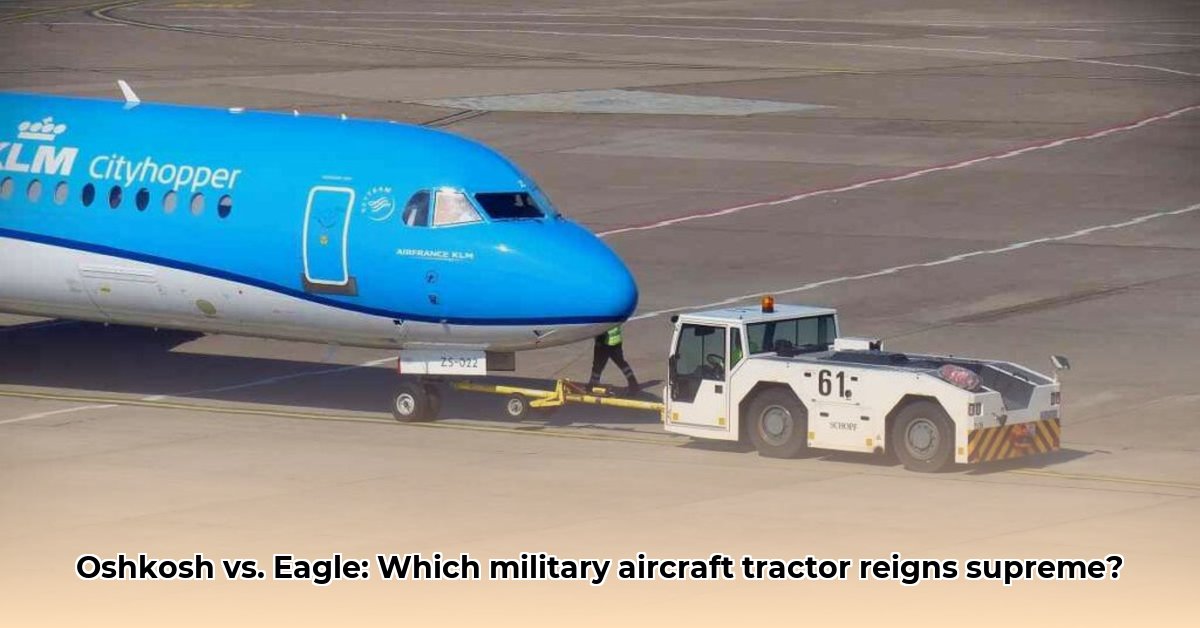
Choosing the right aircraft tractor is crucial for military operations, impacting efficiency, safety, and long-term costs. This report compares Oshkosh AeroTech and Eagle Tugs, analyzing key features to aid procurement decisions. For more detailed information on aircraft tractors, visit this helpful resource.
Towing Capacity & Aircraft Compatibility
Both Oshkosh and Eagle offer models with varying towing capacities to accommodate different aircraft sizes. However, publicly available data for direct comparison is limited. Therefore, independent testing tailored to specific aircraft types and weights is crucial for informed decision-making. Prioritize determining the exact weight and dimensions of the aircraft to be towed before evaluating manufacturer specifications. This ensures compatibility and safety.
Power Systems: Diesel vs. Electric
Oshkosh provides both diesel and electric options, while Eagle primarily offers diesel models. Electric tractors offer lower operating costs due to cheaper electricity, and reduced emissions. However, they require charging infrastructure and their performance might vary in extreme weather conditions. Diesel tractors offer proven reliability and performance but incur higher fuel costs and environmental impact. The optimal choice depends on your base's infrastructure, operational environment, and environmental goals. What are the long-term fuel and maintenance costs associated with each option?
Safety Features
Both manufacturers prioritize safety, incorporating features like enhanced visibility, robust braking systems, and emergency shut-off mechanisms. However, detailed comparisons require analyzing specific model specifications. Consider your airfield's unique safety challenges; for example, low-light conditions or tight turning areas, to select the tractor best suited to mitigate them. Does a specific model provide crucial safety advantages given your base's operational limitations?
Maneuverability & Operational Efficiency
Efficient aircraft movement is critical on busy military bases. Both Oshkosh and Eagle design tractors for maneuverability, but subtle differences in turning radius and ease of operation can significantly impact efficiency. Detailed specifications comparing turning radius, operational speed, and ease of use are essential for evaluating performance within your airfield's layout and operational procedures. How does each tractor’s maneuverability influence overall workflow efficiency at your base?
Maintenance & Reliability
Minimizing downtime is paramount. Diesel tractors might require more frequent scheduled maintenance than electric models, which present different maintenance considerations related to battery life and charging systems. A thorough analysis of warranty terms, projected maintenance costs, and readily available parts is crucial for evaluating the long-term reliability of each option. What is the anticipated impact of downtime due to maintenance on your operational schedule?
Customization & Integration
Military needs often require specialized configurations. Assess the customization options offered by each manufacturer. This includes specialized towing configurations or integrated communication systems for seamless integration into your existing base systems. Detailed specifications from each manufacturer are required to determine the extend to which they can adapt to your specific needs. Can either manufacturer adequately satisfy the unique customization demands of your operation?
Total Cost of Ownership (TCO)
TCO encompasses initial purchase cost, fuel/electricity expenses, maintenance, repairs, and the tractor's lifespan. While precise figures are difficult without specific operational data, a comparative analysis of these factors is vital. Consider the projected lifespan and the impact of fuel costs over the long term. Which option provides better value and lower long-term costs?
Conclusion
Selecting between Oshkosh and Eagle tractors necessitates a thorough evaluation of operational needs, budget, and long-term objectives. No single "best" tractor exists; the optimal choice depends on individual circumstances. Independent testing, detailed manufacturer specifications, and a comprehensive cost-benefit analysis are critical for informed decisions. This detailed assessment helps ensure the selection of the most effective and cost-efficient aircraft tractor for your military base.